#Quick Access Popup
Explore tagged Tumblr posts
Text
New Desktop Dash, No Bueno
Okay so, new dash layout on desktop.
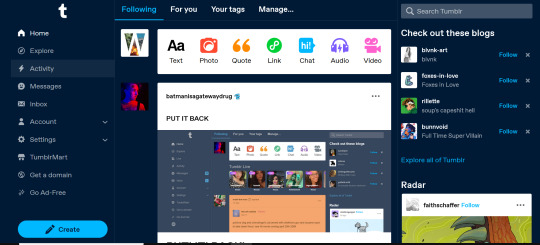
As seems to be a common reaction: not a fan.
Let's talk about some of the issues:
1. Really visually cluttered
The new sidebar crowds out the dashboard content and the bright blue popup notifications (now at the side AND top) and create-post bar pull your eyes in different directions. There is no space for the eye to rest on anymore - it's all noise. The end result is that everything flattens - there's no focal point anymore.
It's also pretty overwhelming - even for someone like me - so I can't imagine it would be very user-friendly to someone who was photosensitive or struggled with visual overload (especially when paired with the high-contrast 'true blue' default site palette and animated icons for the changes-on-tumblr/staff-picks/trending buttons).
2. The activity pop-up now covers dashboard content
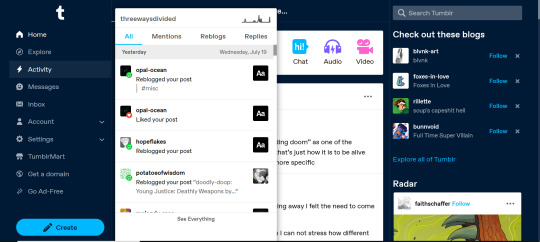
This is really bad from a usability standpoint. In the old layout the activity pop-up used to drop down over the recommended blogs sidebar. Now it actively gets in the way of looking at core content. The dash is why we are here, burying it like this is baffling.
The search bar now drops down over the recommended blogs banner instead, but where the old design had non-critical space on each side of the dashboard to visually allow both features to pop in, this new layout is way worse for efficiency. And for what? Having a rarely-used former drop-down menu now permanently active? The old banner with quick-links for the key use-features (notes, messages, askbox) made much more design sense.
It also means that the activity pop-up gets now completely covered by the blog pop-up that opens when you click the notification, so double demerit there. 0/10.
3. It's harder to navigate to the activity page, and the new page-stretch means you can't see new notes without scrolling down
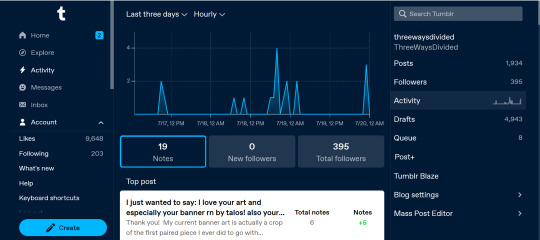
That first bit is kind of a nitpick but cramming the 'See everything' link down at the bottom of a browser window isn't a great navigation choice. (Again, the visual signifiers and eye-direction in this new design are incredibly poor.)
That the main activity page now requires you to scroll to even see the top note due to the new display ratio is really egregious. It makes another key site feature just slightly less convenient and accessible in a very irritating way. Bad choice.
4. The new ratio pushes the Radar and Main Sponsored slot completely off-screen
This one is directed the tumblr staff: that's also a bad choice, guys. That's your main ad-slot for people loading into Tumblr so hiding it is going to hurt both your ad-impressions and your ability to promote the ad-free option. The new layout ratio also means that the in-dash ads are going to be a lot more invasively screen-filling - and let's be real most users will either add-block or leave before purchasing ad-free. I have no idea what the new layout is trying to achieve but if ad optimisation is the goal then this ain't it, chief.
To be honest I cannot comprehend the rationale for this change. I guess it's visually a bit more like Twitter... but that site is currently being demolished from the inside by poor management decisions so maybe it's not the best aesthetic to be aping.
Well then, what do?
Okay so, new dash bad. And so, in true Tumblr spirit: we complain. However, to get results we must deploy the art of kvetching productively.
If you want the old dash back (or at least, a better new-dash design that corrects some of these big weaknesses) what you should do is head over to https://www.tumblr.com/support and lodge a feedback ticket pointing out the problems. The more users who do that, the more likely you are to see an effective response.
Remember, tagging @staff and @support in posts won't fix this. There's no guarantee they'll see it among the notes barrage.
Also: please don't be rude or abusive when you lodge tickets. Whoever is manning those blogs and inboxes probably isn't the person who forced through this change. Save an intern, be polite.

Go forth in disgruntlement to keep this hellhole a hellhome.
#tumblr#tumblr problems#new dashboard#yes it's bad#but there is a way#I've already lodged tickets about it
1K notes
·
View notes
Text
Pikmin 2 Personality Quiz Translation
quick disclaimer: I am not especially fluent in Japanese, I'm just some shmuck trying their best, so take these translations with a grain of salt. especially since there's some i'm really unsure of here.
feel free to play along with this link! or just scroll all the way down to the "results" section at the bottom if you just want to see the descriptions
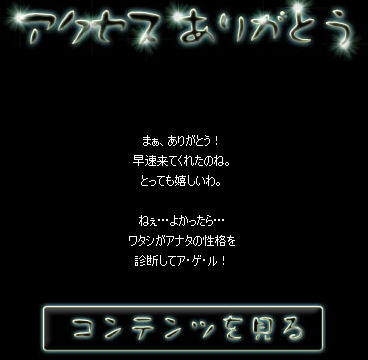
Thank you for Accessing [This Page]
Ahh, thank you! You came right away. I'm so happy.
Hey... If you don't mind... I could examine your personality!
View Content
(note: there's some usage of katakana in the paragraph where it typically wouldn't be, notably for the pronouns 'watashi' and 'anata', so I decided to bold those.)

Pikmin Personality Quiz
Q1: What is the most important thing in your life?
Friends
Money
Family
......
Myself
Q2: Of the following 5 colours, which do you prefer?
Red
Purple
White
Yellow
Blue
Q3: Who can you not say no to?
My parents
My lover
My boss
Myself
There isn't anyone (None)
Q4: What word best describes your lifestyle?
Fearful
Perky
Heart-pounding
Voracious
Impulsive
(note: these are all onomatopoeia in the original, so an exact translation would be impossible, or at least unreasonable. hopefully this does the job fine.)
Q5: You're flying in a spaceship. What happens to you next?
I crash
I sleep
I explore an undiscovered planet
I fall
I go back home
(note: "I fall" could equally be "I fail". it's hard to say with so little context, but either way it's not good.)
Q6: How much money do you have saved up?
No more than 100 yen
No more than 1000 yen
No more than 10,000 yen
No more than 100,000 yen
More than that! I'm rich!
(I'm here for translations, not currency conversions, but this would be (in USD, since I'm pretty sure most of you are American even though I'm not): $0.67, $6.67, $66.72, and $667.21 respectively. the fact this was probably made for children really shows here.)
Q7: What's your favourite game?
The leisurely Animal Crossing.
Pikmin, of course.
As expected, it's Zelda.
Obviously Mario, right?
Actually, it's none of these.
Q8: What's your favourite creature?
Pellet Posy
Iridescent Flint Beetle
Bulborb
Waterwraith
Pikmin
Q9: What's your LEAST favourite creature?
Beady Long Legs
Titan Dweevil
Bulborb
Breadbug
Bumbling Snitchbug
(note: this quiz seems to specifically be related to the New Play Control version of Pikmin 2, so the inclusion of the Titan Dweevil isn't QUITE as spoilery as it seems on first glance)
Q10: What's your favourite place?
Valley of Repose
Awakening Wood
Perplexing Pool
Wistful Wild
Inside the Onion
Q11: During a space trip, you're met with an accident, and end up shipwrecked on an uninhabited planet. What kind of planet is it?
A jungle planet
A sandy planet
A mechanized planet
A planet of bugs
It's actually Earth
Q12: If were shipwrecked on an uninhabited planet and could only bring one thing with you, what would it be?
My secret safe
My Game Boy Advance
My passbook
Lunch
A novel
Q13: If you were to start a family in the future, how many children would you have?
None
One
Two
I don't know
A lot
Q14: How would you describe your interactions with others?
Passionate
Cool
Devoted
Easy to get carried away
I don't care
Q15: Seriously, how old are you?
10 or less
20 or less
40 or less
60 or less
What a rude thing to ask!

Check your personality!
(note: if you click this button before answering all of the questions, you will get a popup saying "Q[earliest unanswered number] has not been entered.")
RESULTS
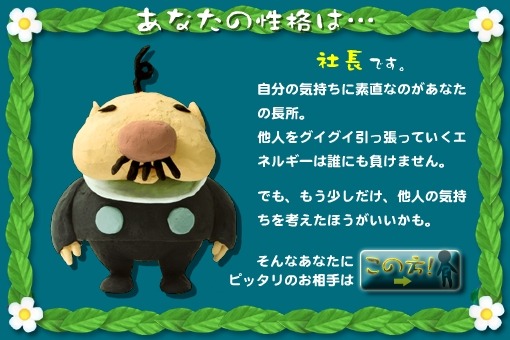
Your personality is [most like]...
The President.
Your strength is that you are honest about your feelings. Your energy as a leader is undefeatable.
However, you should maybe consider other people's feelings at least a little bit.
THIS → is the perfect partner for you!

Your perfect match is...
The President's wife.
She's straightforward about her feelings, more so than you.
She always toys with you.
However, that's because she believes in you.
→ Back
(note: I have absolutely zero confidence in that middle sentence.)
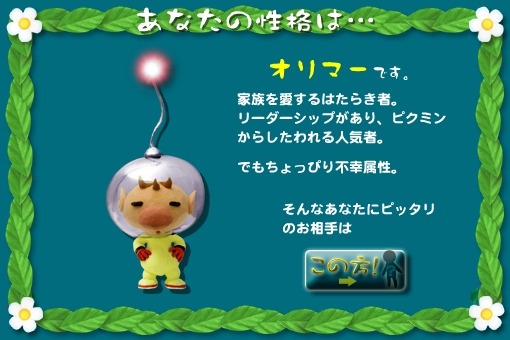
Your personality is [most like]...
Olimar.
A hard-working man who loves his family. He is popular among the Pikmin for his leadership.
However, he's a bit unlucky.
THIS → is the perfect partner for you!
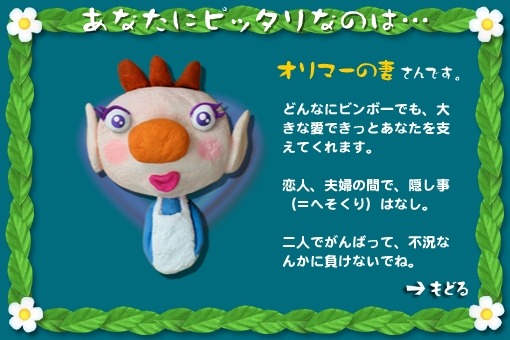
Your perfect match is...
Olimar's wife.
No matter how destitute, she will always support you with great love.
There can be no secrets (such as a certain safe) between lovers or husband and wife.
You two can keep it together and not let the recession get to you.
→ Back
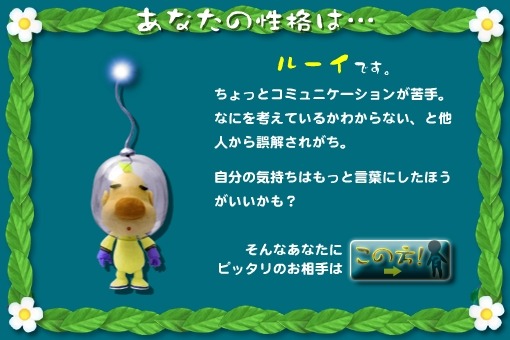
Your personality is [most like]...
Louie.
You're not so good at communication. People tend to misunderstand you, and have no idea what you're thinking.
Maybe you should voice your feelings more often?
THIS → is the perfect partner for you!

Your perfect match is...
Louie's nana.
Her narrow eyes make her look like she can't see anything. But trust me, she definitely sees the real you.
Even if it's hard, please indulge her as much as you can.
→ Back
(note: another really hard phrase to translate on the partner pages, yowch. this time, it was the last line of her description.)
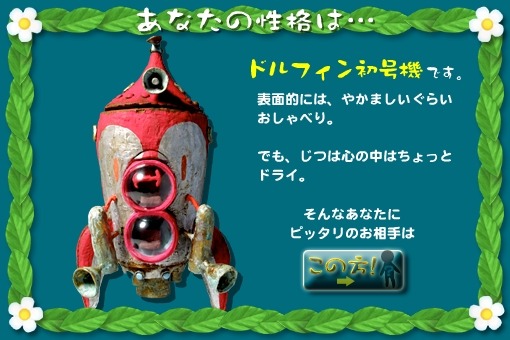
Your personality is [most like]...
The Hocotate Ship.
On the outside, talkative to the point of being a blabbermouth.
But on the inside, actually a bit dry.
THIS → is the perfect partner for you!

Your perfect match is...
Mr. Beady Long Legs.
A strong personality that will really shake your heart. Whether it's out of fear or love, your heart will keep thumping.
Once you get over these feelings, a new you awaits...... Probably.
→ Back
(note: because "さん" is gender neutral, this could equally be Ms. Beady Long Legs. hocotate ship yuri, i GUESS.)

Your personality is [most like]...
The Pikmin.
Serious and hard-working. Your strong suit is cooperating with others. The type to thoroughly devote yourself.
But maybe you could assert yourself a little more?
THIS → is the perfect partner for you!

Your perfect match is...
Mr. Bulborb.
It will lead you with a WILD personality.
A big maw awaits you.
Please look forward to some wild kisses.
→ Back
(note: again, could be Ms. instead)
#Rambles Into The Void#Vesper's Translations#Pikmin#anyways i got the hocotate ship and idk how to feel about that
98 notes
·
View notes
Text


⟢ ∘ 。 FAN BOY BEHAVIOR ⦂ AUGUST 2023 , TUMBLR THEME .
⟡ ⟡ ⟡
∘ 。⟣ briefing : fan boy behavior is my take on the fansite themes that used to be super popular in the rpc ! this theme is packed full of goodies and endless aesthetically pleasing styling opportunities ! perfect for a main , a resource blog , an rph or anything else u see fit ! please give this post a reblog and a like and take care of urself ! keep hydrated and pet a cute animal today !

∘ 。⟣ specs :
an arched shaped header image w/ accent animated icon .
sidebar png .
three creator / admin icons that show names when hovered .
( optional ) accent hearts throughout .
offers accessible font sizing option .
offers 390px post sizing .
draggable calendar window .
popup ' warning ' box .
extra link space on main w/ a quick link box .
animated askbox feature .
one editable link for u to use for whatever .
6 editable links in the nav tab .
subtle fade in tab animation .
complete list of credits and inspirations are detailed in the code .
to view a live preview , please see the source link .
click here to become a patreon and gain access to this code or buy the code for $5.00 usd on payhip !
#rph#indie rph#rp theme#indie rph theme#theme#supportcontentcreators#premium theme#mine#rec#for patreons#for patrons
49 notes
·
View notes
Note
Hiiii Frida, since you are the resident IT wiz among the blogs I follow, I wanted to ask you, are you using the tumblr unfucker at all? Or another sort of.... fixer for the site? I have tumblr unfucker through github, but it's looking a little weird now and I know less than nothing about how to get it to look right. so do you have any recommendations or what do you do?
Hi and thank you, haha! I'm using XKit Rewritten, which exists as an add-on for both Firefox and Chrome, and it's a lifesaver! Among other things it allows quick reblogging/queueing by having this popup appear when you hover over the reblog button (it also tells you if a tag goes over 140 characters):
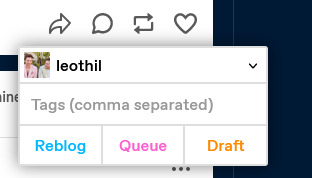
Whenever I use that quick-queue button it also automatically adds my queue tag so I don't have to write it in every time. It has a tag replacer system that I've used a lot this spring to replace my 911 spoilers-tag with just my regular 911-tag after some days have passed since the new episode. It allows me to reformat the timestamps on posts so they look like I prefer:

AND it has a function to restore links to individual posts in the post's header, aka when you click the url of whoever the person on your dash reblogged the post from, you're not brought to their blog but to that specific post on their blog, without having to go through the post menu -> view previous reblog (and this was a real lifesaver in the time period when they'd removed the link to prev post but not yet added that option to the menu).
XKit also has a lot of accessibility and aesthetic options (highlight tags, paint certain blogs certain colours, dim posts you've already seen etc etc), it's a really great browser extension and improves my tumblr experience a lot!
4 notes
·
View notes
Text
🚀 **MAVAS & OPPYO: Your Gateway to Digital Brilliance!**

Click here for full access to oppyo
Hey Tumblr Fam! 🌟
Embark on a journey of online success with MAVAS & OPPYO. 🌐✨ This dynamic duo redefines the game, offering an all-in-one solution to elevate your digital presence.
✅ **Save Time & Effort:** Seamless integration means everything you need is at your fingertips. No more hassle, just results.
✨ **Bring More Growth:** Fortune 500 strategies simplified for YOU. Boost conversions, sales, and overall business growth effortlessly.
🚀 **Start Quick & Easy:** Designed for business owners like you, MAVAS is user-friendly. 24/7 support and free training ensure a smooth takeoff.
🏗️ **Build Your Online Presence:**
- Craft professional websites with drag-and-drop ease.
- Free MAVAS domain & hosting or connect your custom domain.
- Sell unlimited products with zero MAVAS fees for a limited time.
📈 **All-In-One Marketing Magic:**
- High-converting landing pages, fast video hosting, and comprehensive funnels.
- Send emails, utilize dynamic popups, and conduct A/B tests for optimal performance.
- Manage leads, customers, businesses, and teams effortlessly.
Ready to redefine success? Dive into MAVAS & OPPYO now! 🚀✨ #MAVAS #OPPYO #DigitalSuccess #OnlineBusinessGrowth
Click link to learn more
3 notes
·
View notes
Text
EazyLeadz Review - $127 to $1500+ Eazy Pay Days WITHOUT Ads, A Huge Audience
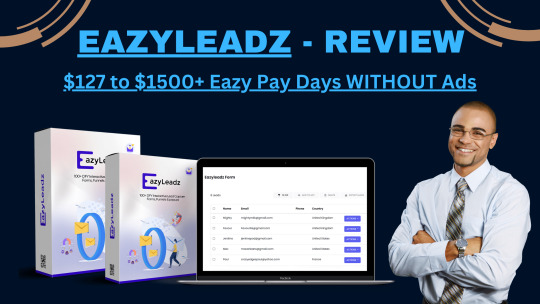
EazyLeadz Review - $127 to $1500+ Eazy Pay Days WITHOUT Ads, A Huge Audience
Works Amazing For Beginners - It’s Your Easiest, Surest & Cheapest Way To Passive Online Income & Daily ChaChing Alerts In 2024!
EazyLeadz Review - Introduction
Welcome to my review of EasyLeadz, arecently launched system that touts itself as a "Lazy man" solution for simplified lead generation and monetization. This tool claims to empower individuals, even those with little experience, to access and profit from substantial buyer leads without the reliance on advertisements, with the ultimate goal of effortlessly boosting their businesses.
In the quest for targeted buyers to promote affiliate products, traditional lead gathering methods are often viewed as time-consuming and challenging, potentially putting a cap on a company's earnings. EasyLeadz positions itself as a solution to this challenge in the business landscape, offering a user-friendly lead generation platform that streamlines the process, enabling users to effortlessly generate targeted traffic for their products.
EasyLeadz goes beyond merely promising increased visibility. It asserts the potential for substantial profits by effectively promoting personal or company products. In a business environment where lead generation is a critical factor for success, EasyLeadz aims to be a convenient and effective solution, presenting a fresh and simplified approach to tapping into and capitalizing on potential customer engagement.
Eazy Leadz Review - Overview
Product Name : EazyLeadz
Vendor : Ekeocha Roland
Front End Price : $17
Product Type : Software
Support : Effective Support
Official Website : Get Access now
Recommended : Highly Recommended
Skill Level Needed : ZERO Skill Levels
Rating : 9.4 out of 10
Ready To Unlock Your Way To Steady Passive Income
& Daily ChaChing Alerts?
RIDICULOUSLY LOW ONE TIME INVESTMENT!
No Monthly Fee Required | Agency/Commercial Rights Included For FREE
Use The Coupon “EAZYLEADZ3” for $3 OFF!
$47/Month $17 OneTime Payment Only If You Act Now!
YES, I’M READY! GIVE MEACCESS NOW!
Eazy Leadz Review – Features
® Unlock 100+ DONE FOR YOU Interactive Lead Capture Forms & Popup Funnels ready to deploy in 60 seconds flat.
® Unique lead form and popup funnel strategy helps users to leverage multi-source traffic(landing pages, websites, social media, etc.) and convert them into engaged leads
® Fast & Easy To Set Up - Deploy In Under 60 Seconds Flat, no skill is required, no prior experience, not even AI prompting.
® 100% Done for you system - Lead magnet, copy, tech, delivery - we’ve LITERALLY done all the work.
® Comes with a monetization kit - we help you build your list and then show you how to make money from it - 100% beginner friendly.
® Users Can Start Getting Results Immediately.
EazyLeadz Review – Benefits
Free List Building:
EazyLeadz streamlines the process of building your list with a 100% Done For You System, ensuring accessibility even for those with minimal experience in digital marketing.
Monetization:
Effortlessly collect payments with 1-Click e-Store Integration, enabling the rapid monetization of your email lists.
Quick Affiliate Review Pages:
Craft affiliate review video pages within minutes, simplifying the promotion of affiliate products and commission earning.
Advanced Funnel Logic:
Leverage advanced logic branching for funnel steps, creating dynamic and personalized experiences for your audience.
Legal Utilization of Video Authority:
Legally harness the influence and authority of top video marketers, enhancing the credibility of your content.
Diverse Video Sources:
Utilize videos from multiple sources, including YouTube and Vimeo, providing flexibility and expanding content options.
Create Captivating Video Funnels:
Easily transform any video into attractive funnels, turning website visitors into active subscribers and customers.
Simple Builder:
Use the easy drag-and-drop tool to create and customize your video funnels effortlessly.
Media Library Access:
Get free access to millions of stock videos, GIFs, and images to make your video funnels visually appealing.
Funnel Analytics:
See how well your funnels are performing with helpful analytics, so you can make smart decisions to improve them.
Mobile-Friendly Pages:
Make sure your video funnels and pages look great and work smoothly on all devices, from phones to computers.
Customization Options:
Personalize your video pages to match your brand, keeping a professional and consistent online presence.
Urgency and FOMO Features:
Add timers for urgency to create a sense of missing out, encouraging more engagement and conversions.
List Management Made Easy:
Effortlessly organize and use your contact information with a simple one-click export to CSV.
Simple Sharing with Hosted Links:
Share your video funnels easily with a wider audience using free hosted links, expanding your reach.
Dashboard for Key Metrics:
Keep an eye on important performance indicators through a clear dashboard, helping you make data-driven decisions to improve your video pages.
In conclusion, EazyLeadz provides a user-friendly solution that combines simplicity, customization, and powerful features to boost your digital marketing efforts.
Get Bonus and Coupon Code >>Click here
EazyLeadz Review– How it works?
Your Subscribers Can Start Getting Results in 3 Simple Steps
Step 1 : Choose a topic you're interested in and pick from more than 100 pre-made plans.
Step 2 : Share your plan to get a simple code that you can put on your pages, websites, or share through our social traffic tool.
Step 3 : Begin attracting and turning traffic from different places into interested leads and sales.
EazyLeadz Review – What BONUS in Ezyleadz?
How About Some Juicy FREE Bonuses Worth $9,375 ONLY For The First 99 Action Takers
(The Ball Is Now On Your Court…)
BONUS #1
How to Add Hundreds of Subscribers Weekly
Achieving success in an online business largely depends on having an opt-in email list with quality subscribers who engage with valuable content, make purchases, or respond to affiliate offers.
However, for many marketers, the challenge lies in driving subscribers to their lists, which can be a daunting task. If you're grappling with the same issue, it's time to take a moment to relax. Here's a valuable package that provides tips on adding hundreds of subscribers to your list every week.
BONUS #2
Free Access to My Email Writa Software
As a marketer online for over 10 years, I've written millions of emails. Let me tell you, writing emails isn't easy, even for short ones.
I want to offer you free access to my email writing software. This tool will make sure your emails grab attention and always get opened.
EazyLeadz Review – OTOS
Font End – $17
® Create up to 20 lead capture campaigns effortlessly.
® Explore a collection of 100+ ready-made lead form templates.
® Receive 100 Done-for-You premium lead magnets.
® Build a substantial list of up to 10,000 engaged email subscribers.
® Enjoy a swift and straightforward setup in under 60 seconds.
® Access a variety of 50+ Done-for-You theme designs.
® Incorporate urgency and FOMO with customizable timers.
® Embed campaigns seamlessly on unlimited pages, websites, or funnels.
® Employ Hello Bar, Sticky Button, and Pop-Up features for optimal engagement.
® Implement Exit Intent Technology and customize settings.
® Tap into a vast network of 5 billion social media traffic sources.
® Track key metrics through a robust analytics dashboard.
® Ensure GDPR compliance with a secure lead generation system.
® Integrate seamlessly with preferred autoresponder service providers.
® Manage local lists and export data to CSV.
® Benefit from multilingual support, covering 108 languages.
OTO 2 – $37/$47
® Construct and tailor extended lead capture pop funnels effortlessly.
® Utilize drag-and-drop simplicity to craft 20 interactive popup funnels.
® Implement lead segmentation to enhance engagement and generate 10 times more leads.
® Deliver multiple magnets efficiently through an extended funnel structure.
® Incorporate gamification strategies for heightened lead generation results.
® Easily set up complex lead funnel branches.
® Access a vast library of millions of stock videos, GIFs, and stock images.
® Deploy advanced logic branching for intricate funnel steps.
OTO 3 – $67/$97
® Unlock limitless campaigns, engaged leads, views, and traffic.
® Opt for a custom domain to elevate your branding.
® Leverage the teams feature for collaborative campaign efforts.
OTO 4
Become a member of the exclusive club for the latest and updated lead generation funnel assets.
Immediately acquire 50 additional Done-for-You (DFY) lead forms and magnets.
Unlock a monthly release of 5 new DFY lead forms.
Enjoy the exclusive option to request specific niches and magnets.
OTO 5
Access a ready-to-use affiliate marketing campaign package.
Follow a step-by-step implementation guide for seamless execution.
Benefit from pre-prepared bonuses, email sequences, and demo walkthrough.
Acquire everything necessary to unlock daily affiliate commissions.
OTO 6 – $97/$147
Achieve success as a software marketer by reselling EazyLeadz.
Offer 100 licenses at $97/$127.
Provide 1000 licenses at $127/$147.
Get Access Now >> Click here
EazyLeadz Review – FAQ
Q: Is EazyLeadz suitable for beginners?
Absolutely! EazyLeadz is specifically designed with beginners in mind, featuring a straightforward setup process and a user-friendly interface that requires no prior experience.
Q: Can I personalize the lead capture forms and popup funnels?
While EazyLeadz provides a variety of ready-made templates, customization options are somewhat limited. However, users can still modify certain elements to align with their branding and preferences.
Q: How quickly can I start seeing results with EazyLeadz?
Users can witness results almost immediately after deploying their campaigns. EazyLeadz is optimized for rapid engagement and conversion, allowing users to capitalize on their efforts swiftly.
Q: Is EazyLeadz suitable for advanced marketers?
While EazyLeadz primarily caters to beginners, advanced marketers can still benefit from its streamlined approach to lead generation. However, they may find themselves desiring more customization options and features tailored to their specific needs.
Q: What support options are available for EazyLeadz users?
EazyLeadz offers comprehensive support to its users, including tutorials, documentation, and direct assistance from the support team. Users can also access community forums for additional guidance and insights.
Q: Can I integrate EazyLeadz with other marketing tools and platforms?
EazyLeadz is designed for seamless integration with various marketing tools and platforms, enabling users to leverage their existing infrastructure while maximizing their lead generation efforts.
EazyLeadz Review – Conclusion
However, users should be cautious about the learning curve, relying too much on internet connectivity, and the potential costs associated with upgrades and reseller accounts. Consider your specific needs and give it a try for a while to see if EazyLeadz is the right fit for you.
Like with any tool, staying informed about updates, actively participating in the community, and making use of available resources will contribute to a more successful experience with EazyLeadz.
Thank you for taking the time to read this detailed review of EazyLeadz. I hope this thorough examination has given you useful insights to help you make a well-informed decision for your online journey.
Get Access Now >> Click here
#digitalmarketing#affiliate marketing#social media#list building#EazyLeadz Review#earn money online#earn money fast#earn from home#freelance#artificial intelligence#make money online#technology#success
2 notes
·
View notes
Text
Building Impactful Websites: Scottsdale and Phoenix Design Insights
Introduction: Importance of Strategic Web Design
In the digital age, a powerful website is not merely an online presence but a tool to drive business growth. Whether you are a local business owner or an entrepreneur aiming to expand your reach, understanding how web design impacts branding, conversions, and user retention is vital. High-quality design creates first impressions that lead to lasting connections. It also improves trust, which is essential when competing in cities with robust economies and diverse business landscapes.
User Experience and Visual Appeal in Web Design
Website visitors form an opinion about your brand within seconds. An intuitive layout, attractive visuals, and mobile responsiveness are key to engaging users. Clean typography, clear calls-to-action, and easy navigation keep users on your site longer. Incorporating local cultural nuances and visual styles helps connect deeply with your target market. In mid-Arizona, people appreciate straightforward yet elegant designs that load quickly and provide value upfront without overwhelming them with too much text or popups.
Enhancing Local Reach through Scottsdale and Phoenix Designs
When focusing on web design scottsdale az, it is important to integrate visuals and features that reflect Scottsdale’s modern desert aesthetics and luxury lifestyle. Meanwhile, web design phoenix az benefits from designs reflecting urban energy combined with user-friendly layouts tailored for diverse business industries. Using engaging visuals aligned with these city identities creates familiarity, trust, and confidence among visitors. These nuances ensure your brand message resonates effectively while positioning your business as an authentic part of the community.
SEO Optimization as a Part of Web Design Strategy
SEO is an integral part of web design, ensuring your website is visible in search results. Optimized headings, fast-loading pages, and responsive design enhance your ranking on Google and other search engines. By incorporating location-based keywords strategically within your website structure, you not only rank higher but also attract customers ready to engage your services. Website architecture and internal linking should be designed to create smooth user journeys, ultimately converting visitors into leads or sales without friction.
Responsive Design for Mobile-First Users
Most customers today browse websites on their phones before making decisions. Hence, your website must adapt seamlessly to various screen sizes. Responsive design ensures readability, quick loading, and easy navigation whether accessed via tablet, mobile, or desktop. This improves user experience while reducing bounce rates. Google also ranks mobile-friendly websites higher in search results, so neglecting this aspect could mean losing potential customers to competitors with better-optimized platforms.
Investing in Professional Web Design
Investing in strong web design means creating a platform that not only looks impressive but also functions efficiently for users and search engines. By understanding your local market needs in Scottsdale and Phoenix, applying strategic SEO, and ensuring responsiveness, your website becomes a growth engine rather than just an online brochure. Prioritizing clarity, speed, and user experience will help you stay ahead in the competitive digital landscape, fostering customer loyalty and sustainable business success.
0 notes
Text
SEO Basics: How to Rank Your Website on Google in 2025 (Step-by-Step Guide!)
In 2025, the digital competition is fiercer than ever. Every business, blog, or brand wants that coveted first-page ranking on Google. But with search algorithms evolving constantly, how do you keep up? More importantly, how do you actually rank? This comprehensive guide will walk you through the essential SEO basics and show you how to rank your website on Google—step by step.
Whether you're a startup founder, content creator, or digital marketer, these actionable strategies are tailored to help you grow your online visibility the right way.
Why SEO Still Matters in 2025
Let’s start with a quick reality check: SEO isn’t dead—far from it. According to Statista, over 5 billion people are using the internet in 2025, and most rely on search engines like Google to find what they need. If your website isn’t optimized for search, you’re missing out on massive organic traffic, leads, and sales.
Step-by-Step Guide: How to Rank Your Website on Google
Step 1: Understand Google’s Ranking Factors
Before diving into technical tweaks, you need to understand what Google looks for. While there are over 200 ranking factors, here are the major ones in 2025:
High-Quality Content that satisfies search intent
Mobile-First Design (Google prioritizes mobile usability)
Page Experience & Core Web Vitals
Backlinks from reputable websites
Structured Data (Schema Markup)
Pro Tip: Google’s Search Central is a valuable resource. Check out their official SEO starter guide.
Step 2: Perform Keyword Research Like a Pro
If you want to rank, you have to start with the right keywords. The key is finding long-tail keywords that match what your audience is searching for.
How to find the right keywords:
Use tools like Ahrefs, SEMrush, or Google Keyword Planner
Focus on keywords with low competition and high search intent
Analyze what’s currently ranking using Google Search or a SERP analyzer
🔍 Example: Instead of targeting "SEO", go for “how to rank your website on Google in 2025”.
Step 3: Create High-Value, Optimized Content
Content is still king—but only when it's helpful. Google’s Helpful Content Update emphasizes content written by people, for people.
Here’s how to optimize your content:
Include the primary keyword ("how to rank your website on Google") naturally 5–8 times
Use H1, H2, and H3 headings for structure
Add internal links to relevant pages on your site
Include external links to authoritative sources
Use images with alt text for accessibility and SEO
📌 Format your content to be scannable:
Use bullet points and numbered lists
Keep paragraphs short (2–4 lines max)
Include a table of contents for longer posts
Step 4: Optimize On-Page SEO
On-page SEO ensures each individual page is fully optimized for search.
Here’s your on-page checklist:
✅ Title Tag: Include the primary keyword
✅ Meta Description: Write a compelling summary (155–160 characters)
✅ URL: Keep it short and keyword-rich
✅ Header Tags (H1, H2, H3): Use them logically
✅ Internal Links: Link to related posts or pages
✅ Alt Text: Describe your images accurately
Step 5: Ensure Your Site is Mobile-Friendly & Fast
In 2025, mobile-first indexing is the default. Google evaluates your mobile site first, not desktop.
Here’s what to do:
Use responsive design
Avoid intrusive popups or interstitials
Optimize your site speed with tools like PageSpeed Insights
Compress images and enable browser caching
📱 Over 70% of users search from mobile devices—make sure your site doesn’t frustrate them.
Step 6: Build High-Quality Backlinks
Backlinks are still a top ranking signal. But not all links are created equal. Aim for links from trusted, high-authority domains.
How to earn quality backlinks:
Create shareable content (infographics, guides, stats)
Guest post on reputable industry blogs
Get featured in roundups and expert interviews
Use broken link building strategies
💡 Example: Write a data-backed article that a university (.edu) site might link to when referencing digital trends.
Step 7: Use Technical SEO and Schema Markup
Technical SEO ensures that search engines can crawl and index your site properly.
Submit your sitemap to Google Search Console
Fix crawl errors and 404s
Use canonical tags to avoid duplicate content
Implement structured data (like FAQs, reviews, events) using Schema.org
Structured data helps your pages appear in rich snippets, which increases your click-through rate.
Step 8: Track, Analyze, and Improve
SEO is not a one-time effort. You must monitor performance and adapt.
Use tools like:
Google Analytics 4 (GA4) to track traffic and behavior
Google Search Console to see keyword rankings and crawl issues
Hotjar or Microsoft Clarity for UX feedback
Regularly update old content, fix errors, and double down on what’s working.
Common SEO Mistakes to Avoid
Even experienced marketers get these wrong:
Keyword stuffing: Use keywords naturally—don’t spam
Ignoring UX: A great design keeps visitors engaged
Forgetting local SEO: Optimize for local searches if you're a regional business
Skipping metadata: Meta tags matter more than you think
Final Thoughts: It’s All About Consistency
Learning how to rank your website on Google is not about chasing hacks—it’s about creating consistent, valuable, and optimized content that truly serves your audience. The tips in this guide are not magic—they’re proven best practices that will help your site grow steadily and sustainably in 2025.
If you’re just starting, don’t be discouraged. Focus on the basics, measure your progress, and improve as you go.
Call-to-Action
Ready to boost your rankings? Start implementing these strategies today. And if you found this guide helpful, share it with others or bookmark it for later.
Need personalized SEO help? Reach out for a free consultation—we’ll help you create a roadmap tailored to your site and goals.
For more info:-
How to Rank Your Website on Google
0 notes
Text
Sikka Gaming – Pocket-Friendly Fun for Every Mood

Introduction Not every day needs a heavy, intense game. Some days, all you want is light, refreshing fun that fits in your pocket. That’s what Sikka Gaming brings—a relaxed way to lift your mood anytime, anywhere.
Features
Mood-Based Game Options: Play depending on how you feel.
Quick Access Anytime: No waiting, just open and start.
Smooth on All Devices: Doesn’t hog memory or drain your phone.
One-Tap Joy: Every game is easy to understand and instantly fun.
No Distractions: No annoying popups or interruptions.
Conclusion Fun that fits your pocket—and your pace. 📲 Download the Sikka Gaming app now and bring cheerful moments into your day.
0 notes
Text
How Data-Driven Marketing is Transforming Brand Strategies in 2025
In the rapidly evolving digital landscape, one thing has become crystal clear—data is no longer just an asset; it’s the backbone of every successful marketing strategy. As we step into 2025, data-driven marketing has transcended from being a buzzword to a necessity, reshaping how brands engage, personalize, and convert their audiences.
Digital marketing is no longer about throwing campaigns into the void and hoping something sticks. With the abundance of customer insights, behavior tracking, and predictive analytics, marketers can now make informed decisions at every stage of the funnel. The best digital marketing companies in Delhi are already leading this shift, leveraging smart data to redefine brand storytelling, customer retention, and ROI optimization.
The Evolution of Data-Driven Marketing
Data-driven marketing refers to the use of customer information, analytics tools, and performance metrics to optimize and personalize marketing efforts. It shifts marketing from being intuition-led to insight-led.
In the early 2010s, digital marketers had limited access to real-time data. They relied heavily on basic analytics tools like Google Analytics to track page visits or bounce rates. Fast-forward to 2025, and marketers now have access to:
Predictive analytics powered by AI
Heatmaps and session recordings
Customer journey mapping tools
Real-time audience segmentation
Behavior-based email and ad automation
This revolution is particularly visible in major business hubs, where competition fuels innovation. It's no surprise that some of the best digital marketing companies in Delhi are setting benchmarks for others by adopting cutting-edge, data-first approaches to strategy.
Why Data-Driven Marketing Works
1. Hyper-Personalization
Today’s consumers expect brands to know them. Generic messaging is a quick path to being ignored. Through data, marketers can segment their audience based on interests, demographics, behavior, and even real-time activity.
For example, instead of sending the same product email to 10,000 people, you can now send 10,000 tailored emails to each individual based on their behavior.
This approach is not just effective—it’s essential. Brands using personalization see a 20% increase in sales on average, and the best digital marketing companies in Delhi are already deploying this across industries such as real estate, e-commerce, and healthcare.
2. Smarter Campaign Optimization
A/B testing has evolved. Today’s platforms allow multivariate testing and live performance tracking that adjusts ads or web content in real-time. This means lower ad spend wastage and higher campaign efficiency.
Marketers can now:
Identify which CTA drives conversions
Discover which landing page design performs better
Measure what time of day or platform yields higher ROI
It’s this level of responsiveness that distinguishes the best digital marketing companies in Delhi from the average ones.
3. Predictive Analytics for Future-Proofing
Using historical and behavioral data, brands can now anticipate trends before they peak. Predictive analytics tools help in:
Forecasting customer churn
Identifying high-value leads
Automating retargeting based on past actions
With AI and machine learning becoming more accessible, even mid-sized businesses can now afford tools that were once reserved for enterprise-level players.
Real-World Use Cases of Data-Driven Strategy
Case Study 1: E-commerce Growth via Behavioral Triggers
An e-commerce brand selling beauty products partnered with a performance agency in Delhi to boost sales. By analyzing customer behavior on the website (cart abandonments, frequent product views, etc.), they implemented behavioral triggers such as:
Exit-intent popups with discount codes
Retargeting ads featuring browsed products
Abandoned cart emails with urgency CTAs
Result? A 38% uplift in sales within 60 days.
And yes, the agency behind this success was among the best digital marketing companies in Delhi.
Case Study 2: Real Estate Brand Targeting NRIs
A luxury real estate developer wanted to reach Non-Resident Indians (NRIs) looking to invest in India. The data team tracked:
Locations with high NRI engagement
Pages with the highest dwell time
Peak interest hours based on time zones
Based on this, they optimized Google Ads and social media campaigns targeting specific cities in the US and UAE, yielding a 65% boost in qualified leads.
Again, this was executed by one of the best digital marketing companies in Delhi, known for its real estate marketing expertise.
Challenges with Data-Driven Marketing (and How to Tackle Them)
1. Data Overload
Having too much data can be as paralyzing as having none. The trick is knowing what to measure and how to interpret it. A clear strategy with defined KPIs is a must.
2. Privacy Concerns and Compliance
With rising consumer awareness and regulations like GDPR and India’s DPDP Act, marketers must balance personalization with privacy. Using consent-based data collection and ethical tracking practices is essential.
3. Lack of Skill or Tools
While tools are available, not every business knows how to use them effectively. That’s where partnering with professionals makes a difference. The best digital marketing companies in Delhi offer not just service, but strategic consultation and training as well.
Tools Powering Data-Driven Marketing in 2025
Here are some of the leading tools being widely adopted:
Customer Data Platforms (CDPs) like Segment or Bloomreach
Behavioral Analytics: Hotjar, CrazyEgg
CRM + Marketing Automation: HubSpot, ActiveCampaign
Data Visualization: Google Looker, Tableau
AI Copy & Design Tools: Jasper, Canva AI
Many of these tools are part of the tech stacks used by the best digital marketing companies in Delhi, enabling them to scale and adapt faster than competitors.
Final Thoughts
Data is the oil of the digital age—but raw oil is useless without refinement. Similarly, customer data is only as powerful as the insights and actions it generates.
Brands that embrace data-driven marketing in 2025 will not only survive but thrive. They will build stronger customer relationships, increase lifetime value, and adapt quickly to market shifts. But navigating this data revolution requires more than just tools—it requires expertise.
That’s where working with the best digital marketing companies in Delhi
0 notes
Text
Crowdsourcing Feedback for E-Filing Portal Enhancements:
As courts increasingly rely on digital platforms for processes like e-filing and e-record renewal of judgments, ensuring that these e-filing portals meet user needs is more critical than ever. But how do courts and technology vendors know what’s working and what’s falling short?
The answer: crowdsourcing feedback directly from the people who use the system every day — attorneys, legal assistants, process servers, and professional filing services.
What Is Crowdsourcing Feedback?
Crowdsourcing feedback is the process of gathering insights, suggestions, and usability concerns from a large, diverse group of users. Instead of relying solely on internal developers or a small committee, courts and e-filing system vendors open up the floor to their broader user base to identify:
✅ Pain points ✅ Feature requests ✅ Workflow inefficiencies ✅ User experience (UX) issues ✅ Technical glitches or access barriers
By tapping into this collective intelligence, e-filing portals can evolve more effectively and stay aligned with the real-world needs of those handling e-file renewal of judgment filings and other legal processes.
Why Crowdsourcing Matters for E-Filing Improvements?
Many e-filing systems were designed with general use cases in mind, but complex filings like e-file renewal of judgment or multi-party renewals reveal nuanced challenges that may not have been considered during initial development.
For example:
Is the upload process intuitive for multi-document filings?
Are there unnecessary redundancies when filing similar cases?
Does the system provide real-time status updates or error feedback?
Are the portal’s technical help features accessible and responsive?
Crowd sourced feedback surfaces these hidden issues and gives courts actionable insights to improve portal design, functionality, and performance.
How Courts Can Effectively Gather Feedback?
Here are some advanced strategies courts and portal vendors can use to engage users in meaningful crowd sourced feedback for e-file renewal of judgment improvements:
✅ User Surveys Send out targeted surveys to attorneys, legal clerks, and filing service providers asking about their portal experiences, challenges, and feature requests.
✅ Feedback Forums and Online Communities Create dedicated online spaces (like forums or Slack groups) where users can share feedback, vote on feature suggestions, and discuss portal usability issues.
✅ Pilot Programs for New Features Before rolling out major enhancements, involve select users in testing beta features — particularly those related to e-file renewal of judgment — and gather their input before a full launch.
✅ Post-Filing Feedback Popups Integrate a quick feedback prompt within the e-filing portal itself, allowing users to rate their experience or flag an issue immediately after completing a submission.
✅ Partnering with Professional Filing Services Collaborate with companies like Countrywide Process, which handles a high volume of e-file renewal of judgment cases and can provide aggregated insights from multiple jurisdictions and user types.
Real-World Impact: How Feedback Can Transform E-Filing?
Crowdsourced feedback has the power to drive meaningful improvements, such as:
Streamlining the steps needed for e-file renewal of judgment submissions
Enhancing error-checking tools to catch common mistakes before submission
Improving mobile accessibility for on-the-go filings
Expanding integration with digital signature and payment platforms
Reducing system downtime and improving portal speed
Ultimately, when courts listen to their users, everyone benefits — legal professionals save time and reduce stress, clerks process filings more efficiently, and the public gains faster access to justice.
Why struggle alone when you can partner with experts who know the e-filing system inside and out?
👉 Countrywide Process is your trusted partner for handling even the most complex e-file renewal of judgment filings. ✅ We stay ahead of portal updates ✅ We handle multi-party and high-volume renewals ✅ We ensure 100% compliance and zero rejections
👉 Click Here to Work with Countrywide Process Today Let our team handle the complexity, so you can focus on winning cases.
#e filing portal#judgment renewal#efiling judgement renewal#efile renewal of judgement#efile and erecord renewal of judgement#renewal of judgement online
0 notes
Text
COMMUNITY TALENT SHOW
kim jiu performes original choreography to "kiss of fire" (ref.)
jiu has started to think about everything since the accident as his "second round of firsts." it sounds dramatic, doesn't it? but that's sort of the point, it makes him want to laugh at the sheer absurdity of it. because this isn't the first time that jiu has performed in public, it's not the first time he's choreographed something of his own, made solely to highlight his best work. but it's the first time since surgery, since weeks of recovery, months of rehab, and all the lingering days of pain and weakness that followed. it's special in that sense, another milestone of accomplishment in his long road of recovery.
still, he's careful. he warms up on the side as he waits for his turn, engaging each muscle and stretching it out, staying supple even as it takes a little bit longer for his invitation to the stage to finally be extended. he hops in place, just a little more than a bounce, and can feel how he still unconsciously favors the injured side. he stops hard twice on that leg, trying to remind his brain to trust that the doctors did their jobs correctly and that he took every precaution in rebuilding his strength since then. they've got this, both he and his weak knee.
the young man lacks any sort of shyness or nerves when he takes the stage. "hello, i'm kim jiu," he announces his own presence politely, though with enough volume that he can be heard without a microphone. "i'll be entertaining you with my own choreography today, if you don't mind lending me your attention for a moment," he grins at the few sparse chuckles from the crowd. not the most engaged audience he's ever stood before but that's nothing that can deter him.
he takes his place at center stage, flashing another quick smile to the audience as he signals to the guy in charge of the music that he's ready to go. there's no count in, no way to tell what the delay will be between tapping the button and when the sound will actually start. but that's alright, it's the benefit of this being jiu's second go-around at firsts; he's seen most of this before. so when the music does start, a little too loud over the speakers in a way that makes some of the cafe-enjoyers jump in their seats, jiu is still ready for it.
i want to show off, he had told hangyeol when he explained to his roommate the silly little talent show he decided to take part in. it's been too long since i really performed, y'know? so i want to make my return to the stage something to remember. he joked about it being cheating when an axis trainee helped him figure out moves that show his level of mastery without straining the weak knee beyond its limits. while jiu can grit his teeth and move through temporary pain, he's too old to let injuries go ignored lest the plague him for weeks afterwards. he's more careful with his body now than he used to be, which has its pros and cons. he's stronger now, a little more muscular than he was even before the accident to compensate for structural weaknesses. it adds a crispness to his movements, a power that he couldn't access before. and yet he's still as smooth as ever, gliding between moves and punctuating them to the beat as he dances.
it's less than a minute and yet his breaths still come a bit labored when the music fades out and he finishes up his performance. when he bows this time, it's with a little bounce still lingering to the remnants of the beat. "thank you!" he waves to the audience as he exits the stage, acting like he had just headlined a music festival instead of an itty bitty popup cafe talent show. the stage is only as small as you let it be, he would tell himself. a grin splits his face at the thought. that felt good.
1 note
·
View note
Text
Browser Extension Development Made Simple and Effective
In today’s digital world, browser extensions have become essential tools that improve productivity, enhance user experience, and add powerful features to everyday web browsing. From ad blockers to password managers, extensions customize the way millions interact with the web. If you’re interested in creating your own browser extension but feel overwhelmed by the process, this guide will simplify development and show you how to build effective, useful extensions.
What Is a Browser Extension?
A browser extension is a small program that adds new features to your web browser. It can change how your browser works, make websites look different, or help you do things faster. Big browsers like Chrome, Firefox, Edge, and Safari all let you use extensions.
Extensions are built using web technologies you likely already know: HTML, CSS, and JavaScript. This means if you have basic web development skills, you’re already halfway to creating your own extension!
Why Develop a Browser Extension?
Developing browser extensions offers many benefits:
Solve Real Problems: Extensions can automate repetitive tasks, block unwanted content, or provide quick access to important tools.
Wide Audience: With millions of users on browsers like Chrome and Firefox, your extension can reach a huge audience.
Improve Skills: Building extensions deepens your understanding of JavaScript, browser APIs, and web security.
Monetization Opportunities: Popular extensions can generate revenue through premium features or partnerships.
How Browser Extensions Work: Key Components
Before diving into development, it helps to understand the main parts of a browser extension:
1. Manifest File (manifest.json)
This is the extension’s blueprint. It defines important information like the extension’s name, version, permissions, and which scripts or pages to load. Every extension requires this file.
2. Background Script
Runs in the background and listens for events or messages. It can manage long-running tasks, store data, or interact with browser APIs.
3. Content Scripts
These scripts run inside web pages and can modify page content or interact with the page’s DOM (Document Object Model). For example, a content script could highlight certain words or remove ads.
4. Popup UI
Many extensions include a popup window that appears when you click the extension icon. This UI is built using HTML, CSS, and JavaScript, allowing users to interact with the extension.
5. Options Page
Allows users to customize the extension settings. This page is optional but useful for extensions with configurable features.
Step-by-Step Guide to Building a Simple Browser Extension
Step 1: Create Your Project Folder
Step 2: Add manifest.json
Step 3: Create the Popup UI
Step 4: Add the Popup Script
Step 5: Add Icons
Step 6: Load Your Extension into Chrome
Tips for Effective Browser Extension Development
1. Keep Permissions Minimal
Only request the permissions your extension truly needs. This builds trust with users and simplifies the review process when submitting to stores.
2. Focus on User Experience
Make your extension simple and intuitive. Clear buttons, helpful tooltips, and smooth interactions encourage positive user feedback.
3. Test on Different Browsers
If you want to support multiple browsers, test your extension on Chrome, Firefox, Edge, and Safari. Most browsers support similar APIs, but some differences require tweaks.
4. Handle Errors Gracefully
Use error handling in your code to avoid crashes or broken functionality. This also helps in debugging issues during development.
5. Update and Maintain Your Extension
Keep your extension updated to support new browser versions and fix bugs. Regular updates improve security and performance.
Publishing Your Extension
Once your extension is ready and well-tested, you can publish it on browser stores:
Chrome Web Store: Requires a developer account and a one-time registration fee. Your extension undergoes a review before going live.
Mozilla Add-ons (AMO): Firefox’s official store also reviews submissions for quality and security.
Microsoft Edge add-ons work in a similar way because Edge is built on the same technology as Chrome.
Safari Extensions: Published via Apple’s Developer Program, often requiring additional steps.
Each platform has detailed guidelines, so review them carefully to ensure smooth approval.
Real-World Examples of Browser Extensions
Ad Blockers: Block ads on web pages to improve speed and reduce clutter.
Password Managers: Securely store and autofill passwords.
Productivity Tools: Save bookmarks, track tasks, or take screenshots.
Theme Customizers: Change colors and fonts on websites.
Social Media Helpers: Schedule posts or analyze engagement.
These examples show how diverse extensions can be, highlighting the creative potential for developers.
Final Thoughts
Developing browser extensions is a rewarding way to solve everyday browsing challenges and reach millions of users worldwide. With basic web development skills, you can create useful tools that improve both personal workflows and general user experience.
Starting simple—with a clear idea and small, focused functionality—is the best way to succeed. Then, build on that foundation with more features and polish.
Remember, extensions are all about enhancing the user’s browser journey. Keep their needs in mind, and you’ll build effective, popular tools.
Source by
https://webdeveloperservicesinindia.blogspot.com/2025/05/browser-extension-development-made.html
0 notes
Text
YITH Easy Login & Register Popup nulled plugin 2.4.0

Enhance User Experience with YITH Easy Login & Register Popup Nulled Plugin – Free & Fully Functional! Looking to streamline customer access to your site? The YITH Easy Login & Register Popup nulled plugin gives you premium convenience without the cost! Effortlessly add stylish login/registration popups, reduce checkout friction, and boost conversions with this powerful tool. This nulled version offers all the benefits of the original plugin: customizable popup designs, social login integration, and seamless WooCommerce compatibility. Installation is quick and hassle-free, helping you improve user experience in minutes. Why pay for premium when you can get professional login features for free? Download the YITH Easy Login & Register Popup nulled plugin today and create a smoother path to customer engagement!
0 notes
Text
YITH Easy Login & Register Popup nulled plugin 2.4.0

Enhance User Experience with YITH Easy Login & Register Popup Nulled Plugin – Free & Fully Functional! Looking to streamline customer access to your site? The YITH Easy Login & Register Popup nulled plugin gives you premium convenience without the cost! Effortlessly add stylish login/registration popups, reduce checkout friction, and boost conversions with this powerful tool. This nulled version offers all the benefits of the original plugin: customizable popup designs, social login integration, and seamless WooCommerce compatibility. Installation is quick and hassle-free, helping you improve user experience in minutes. Why pay for premium when you can get professional login features for free? Download the YITH Easy Login & Register Popup nulled plugin today and create a smoother path to customer engagement!
0 notes
Text
Raaghits.com — Your One-Stop Destination to Download Music in Any Indian Language!
Are you a true desi music lover who craves the latest tracks in Tamil, Telugu, Hindi, Punjabi, Kannada, or Malayalam? Whether you’re looking for devotional melodies, sizzling film songs, or soulful independent hits — Raaghits.com has you covered!
🎧 Why Raaghits.com?
India is home to a rich tapestry of musical cultures, and Raaghits brings them all together in one seamless platform. From the foot-tapping beats of Bollywood party anthems to the soothing Carnatic classics of the South — you can discover and download songs in your preferred language, genre, and style, all in one place.
With a user-friendly interface and constantly updated catalog, Raaghits is perfect for those who want:
✅ Free music downloads
✅ High-quality audio files
✅ A vast library in multiple Indian languages
✅ Trending songs & classic hits
✅ Easy navigation without annoying popups
🎶 What’s in Store?
At Raaghits.com, you’ll find curated playlists, new song alerts, and quick access to:
🔥 Latest Bollywood releases
🎤 Tamil, Telugu & Kannada film songs
🎵 Punjabi hits and romantic ballads
🎹 Instrumentals, BGM, and devotional tracks
🎼 Albums from top Indian composers and indie artists
🌐 Easy, Instant Access
Just visit https://raaghits.com/, browse your favorite category or search by artist, film, or song title — and download instantly. No signup, no hassle!
1 note
·
View note